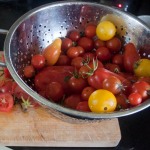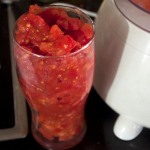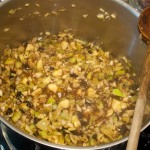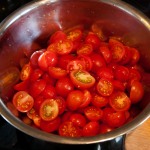Summer days are here at last, and for those of us who grow our own fruit and vegetables, that means the summer gluts are starting, too. Wild rocket is really very easy to grow, which is great, as the sad little plastic salad bags at the supermarket cost a small fortune! Even if you only have space for a window box or a pot on a sunny doorstep, you’re quite likely to be able to grow more of this really punchy, peppery salad leaf than you can bear to eat in salad. Even better, wild rocket is perennial, which means that you only have to plant it once and it will come back, year after year. In the garden of our last house, we ended up with a big clump of wild rocket growing at the edge of the lawn which served us for many years.
A few weeks ago, I transplanted three rather sad looking overwintered plants from an exhausted grow-bag into one of the raised beds in my poly-tunnel. And look what happened!
There you go, straight away – more rocket than I can possibly eat! And then, I thought – I wonder if I can make pesto with this stuff? It’s punchy, peppery, and in many respects quite like basil, so I was hopeful. A quick search around the internet confirmed my suspicions that it should be possible, so I got picking.
For my batch of pesto, which filled an average-sized jam jar with a little to spare, I used –
- 120g of freshly picked wild rocket leaves. To give you a rough idea of how much rocket that is, the supermarket packs of rocket leaves are usually between 50g and 70g.
 3 large cloves of garlic
3 large cloves of garlic- 50g pine kernels, lightly toasted in a dry frying pan
- 50g good quality parmesan cheese
- Plenty of good extra virgin olive oil
- One lemon
- A pinch of salt
Wash your rocket, removing tougher stems and any flower stalks, and dry it in a salad spinner (or give it a really good shake in a colander with a plate over the top).
You can make this pesto in a pestle and mortar (in fact, it’s my favourite way of making small batches of basil pesto, as you keep closer control over the texture and you’re much less likely to over process) but given the quantities I used my food processor for this batch. First, blitz the garlic cloves with a pinch of salt until they’re finely chopped down. Then add the parmesan, and reduce to crumbs, before adding the pine kernels. Aim to retain some texture in the pine kernels, you’re not trying to purée them!
Once that’s done, add the rocket, a handful at a time, adding some olive oil as you go if the mix gets a bit dry. Aim to retain a little texture in the mix.
Once it looks like this, squeeze in the juice of half a lemon, mix well, and add oil until it reaches the texture you prefer. Taste – you’ll find it punchy, peppery, and pungent – and add more lemon juice if you feel it’s needed. You won’t need to add pepper – trust me on this! – but you may want to add a little more salt at this stage, too.
The pesto will store for a few days in a screw-top jar in the refrigerator. Keep the surface covered with a layer of olive oil to prevent oxidation. If you want to store your pesto for longer, you can freeze it in an ice cube tray, and take it out in single-serve portions. How clever is that?
Use your rocket pesto any way you would use the basil kind. It’s wonderful stirred through pasta or, particularly, gnocchi. Add a few little dabs to the top of your pizza before baking. Or spread it on burger buns as a punchy, peppery relish.
Read more from the Country Skills blog >






























































